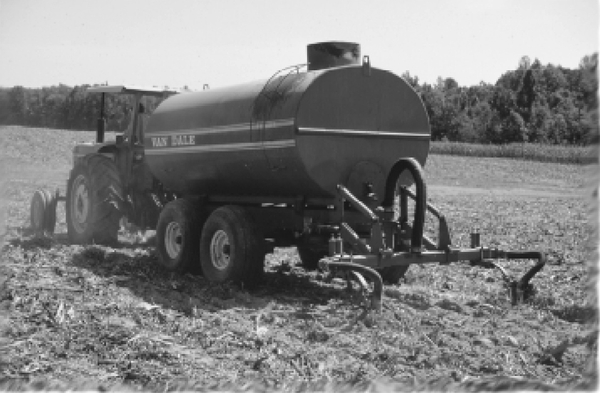Information presented in manufacturer's charts are based on average operat ing conditions for relatively new equipment. Discharge rates and application rates change over time as equipment gets older and components wear. For pump and haul application equipment, application rates and patterns may vary depending on forward travel and/or PTO speed, gear box settings, gate openings, operating pressures, spread widths, and overlaps.
Equipment should be calibrated on a regular basis to ensure proper appli cation rates and uniformity. Calibration is a simple procedure involving col lecting and measuring the material being applied at several locations in the application area. Calibration helps ensure that nutrients from animal waste are applied efficiently and at proper rates.
Pump and Haul Application Systems
Liquid applicators and tank spreaders are an alternative to irrigation systems for transporting and apply ing liquid lagoon effluent, liquid manure slurries, and lagoon sludges. Proper location and design of pump ing and loading pads are necessary to protect equip ment and operators and avoid damaging the lagoon dike or embankment. Care should be taken to minimize spills during loading and transport.
Semi-solid (slurry) applicators can be calibrated by one of two methods: load-area method, and weight area method (see AG-553-4). Liquid applicators are best calibrated by the load-area method.
Load-Area Method
To use the load-area method, you must know the spreader capacity. Spreader capacity is normally rated by the manufacturer and often is indicated on the application equipment. Liquid spreaders are normally rated in gallons while semi-solid spreaders are rated in either bushels or cubic feet.
As the name implies, the load-area method involves applying a full load to a measured area. For ease of measurement, it is best to use a rectangular field pattern. For PTO-driven spreaders, application rate is dependent on ground speed so a uniform speed must be maintained throughout the swath length. Ground-driven applicators apply reasonably uniform rates independent of ground speed.
Load-Area Method Calibration Procedure
- Spread at least one full load of manure in a rectangular field pattern.
- Measure the length and width of coverage. Do not include the outer fringe areas of the coverage which receive much lighter applications than the overlapped areas.
- Multiply the length (feet) by the width (feet) and divide by 43,560 to determine the coverage area in acres.
- Divide the weight or volume of load of manure in the spreader by the acres covered to determine the application rate in tons or gallons per acre.
- If the application rate (Item 4) is not acceptable, repeat the procedure at different spreader settings, speeds, or both until the desired application rate (tons or gallons per acre) is achieved.
Calibrating Liquid Manure Spreaders Using the Load-Area Method
-
Determine the capacity of the manure spreader.
- __________ gallons
-
Spread at least one full load using the regular spreading patterns of the applicator.
-
Forward speed, gear, or throttle setting
Trial 1 Trial 3 Trial 3 - PTO speed or setting
Trial 1 Trial 3 Trial 3 - Spreader gate setting
Trial 1 Trial 3 Trial 3
-
-
Measure the area of spread.
- Spread area width
Trial 1 Trial 3 Trial 3 ft ft ft - Spread area length
Trial 1 Trial 3 Trial 3 ft ft ft - Spread area (e × f)
Trial 1
Trial 3 Trial 3 ft2 ft2 ft2 - Spread area (g + 43,560)
Trial 1
Trial 3 Trial 3 acre acre acre
- Spread area width
- Compute the manure application rate:
- Number of loads spread
Trial 1 Trial 3 Trial 3 - Capacity per load (a)
Trial 1 Trial 3 Trial 3 gallons gallons gallons - Total manure spread (i × j)
Trial 1 Trial 3 Trial 3 gallons gallons gallons - Application rate (k + h)
Trial 1 Trial 3 Trial 3 gal/acre gal/acre gal/acre
- Number of loads spread
- Compute the nutrient application rate:
- Manure analysis
Nutrient Trial 1 Trial 3 Trial 3 N
lbs/1000 gallons lbs/1000 gallons lbs/1000 gallons P2O5 lbs/1000 gallons lbs/1000 gallons lbs/1000 gallons K2O lbs/1000 gallons lbs/1000 gallons lbs/1000 gallons - Application rate (I × manure analysis number + 1000)
Nutrient Trial 1 Trial 3 Trial 3 N
lbs/acre lbs/acre lbs/acre P2O5 lbs/acre lbs/acre lbs/acre K2O lbs/acre lbs/acre lbs/acre
- Manure analysis
-
If the application rate is not acceptable, repeat the procedure at different spreader settings, speeds (Item 2), or both, until the desired application rate is achieved.
2,500 copies of this public document were printed at a cost of $577, or $.23 per copy.
Publication date: July 1, 1997
Reviewed/Revised: Sept. 17, 2024
AG-553-05
N.C. Cooperative Extension prohibits discrimination and harassment regardless of age, color, disability, family and marital status, gender identity, national origin, political beliefs, race, religion, sex (including pregnancy), sexual orientation and veteran status.

